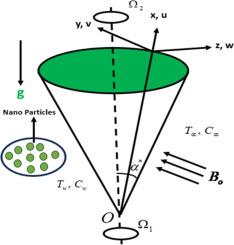具有化学反应的对流辐射锥型磁驱动纳米材料旋转流的数值模拟
IF 7.1
Q1 ENGINEERING, CHEMICAL
引用次数: 0
摘要
纳米液体由于其独特的热属性和良好的应用前景,在传热领域得到了广泛的关注。与传统液体相比,纳米颗粒在纳米液体中的随意运动增强了流体的湍流性,实现了优越的热效率,降低了热阻。纳米液体在插图、太阳能、电子芯片、汽车散热器和热交换器等方面有着广泛的应用。本文报道了受旋转锥约束的化学反应性电磁纳米材料耗散流。流动表达式包括热溶质浮力、变粘度和磁流体力学。考虑了辐射热、热泳、粘性耗散、布朗扩散、热源和一级化学反应来模拟输运表达式。引入相关变量,将偏微分数学表达式转化为数学普通表达式。在MATLAB中利用bvp4c算法对无量纲数学表达式进行了数值求解。通过图形和算术表示探讨了无量纲量的综合结果。结果表明,变粘度、普朗特数和非定常参数的增大使温度下降,而辐射参数、Eckert数、热透参数、产热和布朗扩散变量的增大使温度升高。研究方向涉及制冷、导电、集热、纳米材料加工等领域。本文章由计算机程序翻译,如有差异,请以英文原文为准。

Numerical simulation of magnetically driven nanomaterial rotating flow configured by convective-radiative cone with chemical reaction
Indeed, nanoliquids have acquired substantial consideration in heat transference field because of their inimitable thermal attributes and favorable application likelihoods. In contrast to orthodox liquids, the haphazard movement of nanoparticles within nanoliquid strengthens fluid turbulence, accomplishes superior thermal effectiveness and declines thermal resistance. Nanoliquids have ample utilization, for illustration, solar energy, electronic chips, automotive radiators and heat exchangers etc. This communication reports chemically reactive electro-magnetized nanomaterial dissipative flow confined by rotating cone. Flow expressions include thermo-solutal buoyancy, varying viscosity and magneto-hydrodynamics. Radiative heat, thermophoresis, viscous dissipation, Brownian diffusion, thermal source and first order chemical reaction are pondered to model transport expressions. Relevant variables are introduced to transfigure partial differential mathematical expressions to mathematical ordinary ones. Numerical outcomes for non-dimensional mathematical expressions are reported via bvp4c algorithm in MATLAB. The comprehensive results featuring dimensionless quantities are explored through graphs and arithmetic representations. It is evaluated that escalating values of variable viscosity, Prandtl number and unsteady parameter decline temperature but temperature is improved as a consequence of progressive variation in radiation parameter, Eckert number, thermophoresis parameter, heat generating and Brownian diffusive variables. The study is relevant to cooling industry, electroconductive, thermal collector and nano-materials processing.
求助全文
通过发布文献求助,成功后即可免费获取论文全文。
去求助
来源期刊

Chemical Engineering Journal Advances
Engineering-Industrial and Manufacturing Engineering
CiteScore
8.30
自引率
0.00%
发文量
213
审稿时长
26 days
 求助内容:
求助内容: 应助结果提醒方式:
应助结果提醒方式:


